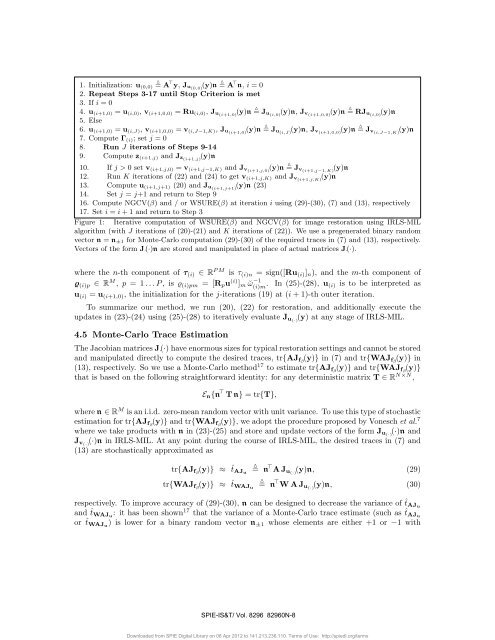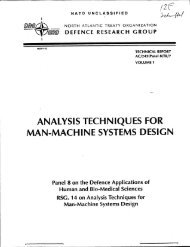Iterative Weighted Risk Estimation for Nonlinear Image Restoration ...
Iterative Weighted Risk Estimation for Nonlinear Image Restoration ...
Iterative Weighted Risk Estimation for Nonlinear Image Restoration ...
You also want an ePaper? Increase the reach of your titles
YUMPU automatically turns print PDFs into web optimized ePapers that Google loves.
1. Initialization: u △ (0,0) = A ⊤ y, J u(0,0) (y)n = △ A ⊤ n, i =02. Repeat Steps 3-17 until Stop Criterion is met3. If i =04. u (i+1,0) = u (i,0) , v (i+1,0,0) = Ru (i,0) , J u(i+1,0) (y)n = △ J u(i,0) (y)n, J v(i+1,0,0) (y)n = △ RJ u(i,0) (y)n5. Else6. u (i+1,0) = u (i,J) , v (i+1,0,0) = v (i,J−1,K) , J u(i+1,0) (y)n = △ J u(i,J) (y)n, J v(i+1,0,0) (y)n = △ J v(i,J−1,K) (y)n7. Compute Γ (i) ;setj =08. Run J iterations of Steps 9-149. Compute z (i+1,j) and J z(i+1,j) (y)n10. If j>0setv (i+1,j,0) = v (i+1,j−1,K) and J v(i+1,j,0) (y)n = △ J v(i+1,j−1,K) (y)n12. Run K iterations of (22) and (24) to get v (i+1,j,K) and J v(i+1,j,K) (y)n13. Compute u (i+1,j+1) (20) and J u(i+1,j+1) (y)n (23)14. Set j = j+1andreturntoStep916. Compute NGCV(β) and / or WSURE(β) at iteration i using (29)-(30), (7) and (13), respectively17. Set i = i +1andreturntoStep3Figure 1: <strong>Iterative</strong> computation of WSURE(β) andNGCV(β) <strong>for</strong> image restoration using IRLS-MILalgorithm (with J iterations of (20)-(21) and K iterations of (22)). We use a pregenerated binary randomvector n = n ±1 <strong>for</strong> Monte-Carlo computation (29)-(30) of the required traces in (7) and (13), respectively.Vectors of the <strong>for</strong>m J·(·)n are stored and manipulated in place of actual matrices J·(·).where the n-th component of τ (i) ∈ R PM is τ (i)n =sign([Ru (i) ] n ), and the m-th component ofϱ (i)p ∈ R M , p =1...P,isϱ (i)pm =[R p u (i) ] m ˘ω −1(i)m . In (25)-(28), u (i) is to be interpreted asu (i) = u (i+1,0) , the initialization <strong>for</strong> the j-iterations (19) at (i + 1)-th outer iteration.To summarize our method, we run (20), (22) <strong>for</strong> restoration, and additionally execute theupdates in (23)-(24) using (25)-(28) to iteratively evaluate J u(·)(y) at any stage of IRLS-MIL.4.5 Monte-Carlo Trace <strong>Estimation</strong>The Jacobian matrices J·(·) have enormous sizes <strong>for</strong> typical restoration settings and cannot be storedand manipulated directly to compute the desired traces, tr{AJ fβ (y)} in (7) and tr{WAJ fβ (y)} in(13), respectively. So we use a Monte-Carlo method 17 to estimate tr{AJ fβ (y)} and tr{WAJ fβ (y)}that is based on the following straight<strong>for</strong>ward identity: <strong>for</strong> any deterministic matrix T ∈ R N×N ,E n {n ⊤ T n} =tr{T},where n ∈ R M is an i.i.d. zero-mean random vector with unit variance. To use this type of stochasticestimation <strong>for</strong> tr{AJ fβ (y)} and tr{WAJ fβ (y)}, we adopt the procedure proposed by Vonesch et al. 7where we take products with n in (23)-(25) and store and update vectors of the <strong>for</strong>m J u(·)(·)n andJ v(·)(·)n in IRLS-MIL. At any point during the course of IRLS-MIL, the desired traces in (7) and(13) are stochastically approximated astr{AJ fβ (y)} ≈ ˆt AJu△= n ⊤ AJ u(·)(y)n, (29)tr{WAJ fβ (y)} ≈ ˆt WAJu△= n ⊤ WAJ u(·)(y)n, (30)respectively. To improve accuracy of (29)-(30), n can be designed to decrease the variance of ˆt AJuand ˆt WAJu : it has been shown 17 that the variance of a Monte-Carlo trace estimate (such as ˆt AJuor ˆt WAJu ) is lower <strong>for</strong> a binary random vector n ±1 whose elements are either +1 or −1 withSPIE-IS&T/ Vol. 8296 82960N-8Downloaded from SPIE Digital Library on 06 Apr 2012 to 141.213.236.110. Terms of Use: http://spiedl.org/terms
















